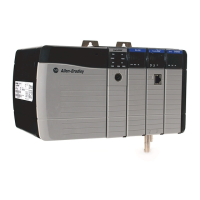Process Control Instructions
22 Rockwell Automation Publication 1756-RM006K-EN-P - November 2018
ALARM Structure
Input Parameter Data Type Description
EnableIn BOOL Enable input. If false, the instruction does not execute and outputs
are not updated.
Default is true.
In REAL The analog signal input.
Valid = any float
Default = 0.0
HHLimit REAL The high-high alarm limit for the input.
Valid = any real value
Default = maximum positive value
HLimit REAL The high alarm limit for the input.
Valid = any real value
Default = maximum positive value
LLimit REAL The low alarm limit for the input.
Valid = any real value
Default = maximum negative value
LLLimit REAL The low-low alarm limit for the input.
Valid = any real value
Default = maximum negative value
Deadband REAL The alarm deadband for the high-high to low-low limits
Valid = any real value 0.0
Default = 0.0
ROCPosLimit REAL The rate-of-change alarm limit in units per second for a positive
(increasing) change in the input. Set ROCPosLimit = 0 to disable
ROC positive alarming. If invalid, the instruction assumes a value of
0.0 and sets the appropriate bit in Status.
Valid = any real value 0.0
Default = 0.0
ROCNegLimit REAL The rate-of-change alarm limit in units per second for a negative
(decreasing) change in the input. Set ROCNegLimit = 0 to disable
ROC negative alarming. If invalid, the instruction assumes a value of
0.0 and sets the appropriate bit in Status.
Valid = any real value 0.0
Default = 0.0
ROCPeriod REAL Time period in seconds for calculation (sampling interval) of the
rate of change value. Each time the sampling interval expires, a
new sample of In is stored, and ROC is re-calculated. Instead of an
enable bit like other conditions in the analog alarm, the rate-of-
change detection is enabled by putting any non-zero value in the
ROCPeriod.
Valid = 0.0 to 32767.0
Default = 0.0.

